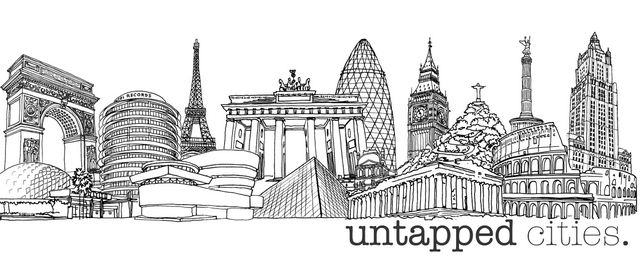How to See the Liberty Bell...in Queens
A copy of the famous American bell can be found inside a bank, which itself is modeled after Independence Hall!


When Untapped Cities asked me to create a world landmark graphic for the site’s relaunch, I was honored. It was a challenge to choose between the many incredible landmarks of all the cities covered by Untapped. The architectural landmarks that made the cut, from left to right, are below:
Top Row:
The Washington Square Arch has been a staple of the park since 1889. Designed by Stanford White, the arch was first built out of wood to commemorate the 100th anniversary of George Washington’s inauguration. The prominent citizens loved it and paid for White to design it in marble.
The Capitol Records Building stands 13 stories tall, with famous echo chambers built under the streets of Los Angeles. The wide curved awnings over the windows make the building look like a stack of records. Ever since its opening, the blinking light atop the tower spells out the word “Hollywood” in Morse code.
The Eiffel Tower was on my “must include” list. Standing at 81 stories high, it defines not only Paris, but the entire country of France. During its construction, the Eiffel Tower surpassed the Washington Monument to become the tallest man-made structure in the world. It held that record for 41 years until 1930 when the Chrysler Building in New York City was completed.
The Brandenburg Gate is one of the most recognizable landmarks in Germany and represents the tumultuous European history, but is also a sign of unity and peace. The Berlin Wall actually enclosed the gate and was off limits to both East and West Berlin during World War II. The gate is the Times Square of Germany, hosting festive New Years Eve celebrations.
Despite the overall curved glass shape of the Gherkin Building, the lens-shaped cap at the very top is the only piece of curved glass on the building. The term gherkin is used to refer to a savory pickled cucumber and was bestowed on this building by the people of London due to its unique shape.
The Big Ben (London) is another structure that represents an entire country. The tower is part of Westminster Palace, and was known as the “Clock Tower” until the celebration of the Diamond Jubilee of Queen Elizabeth II, when it was renamed The Elizabeth Tower. It holds the largest four-faced chiming clock in the world and is the third-tallest free-standing clock tower.
The Christ the Redeemer statue has been looking over the people of Rio de Janerio, Brazil since 1931. Even though Christ is associated with Christianity, the statue with open arms is a symbol of peace. Maintenance work needs to be conducted periodically due to erosion and occasional lightning storms to which the statue is exposed.
The Victory Column was erected to commemorate the Prussian victory in the Danish-Prussian War in 1864. The people of Berlin nicknamed the bronze sculpture of the Roman God Victoria, Goldelse, meaning “Golden Lizzy”. Surrounded by a traffic circle, the column is accessible to pedestrians through four tunnels.
The Woolworth Building has sat on a half acre of land on the tip of New York city for 100 years. Although the building is the Woolworth Company’s namesake, it only occupied one and a half floors in the time of the building’s completion. The Lincoln American Tower in Memphis, Tennessee is a one-third replica of this NYC landmark.
Bottom Row:
The Cinerama Dome in Hollywood, was designed to show widescreen films using a groundbreaking three-projector process (Cinerama). But when it opened in 1963 it used a single projector. It fell into disuse when multi-plexes gained popularity. After a renovation in 2000 it reopened and for the first time started showing movies in the three-projector format.
Situated on the Upper East Side of NYC, the Guggenheim Museum was designed by Frank Lloyd Wright. After 15 years, 700 sketches, and six sets of working drawings, Wright finally settled on a design that included a spiral ramp that circled the lobby atrium. Originally Wright wanted to construct the building out of red marble and weathered green copper.
The Louvre pyramid beautifully juxtaposes the Louvre Palace in Paris. Commissioned in 1984 to serve as a new entrance to the Louvre Museum, to alleviate the large amount of daily visitors. Although many museums have constructed similar pyramids, there is only one true “twin”. I. M. Pei designed both the Louvre pyramid as well as the Rock and Roll Hall of Fame Museum in Cleveland, which includes a glass pyramid.
The Parthenon (Greece) is the oldest structure in the graphic, having been completed in 438 BC. The Parthenon that stands today replaced an older temple that was destroyed in 480 BC. Originally, it was a temple dedicated to the goddess of Athena. Then it was a treasury of the Delian League. In the 5th century it was converted to a Christian church, then in 1460 it was a mosque. It was still in one piece when it was an Ottoman ammunition dump in 1687, until the ammunition was ignited by the Venetians.
If you had to pick one building to represent Italy it would be the Colosseum. In 1585 the pope planned to turn it into a wool factory to employ Rome’s prostitutes. Recently the Colosseum has become a symbol of the campaign against capital punishment. The color of the Colosseum’s night time illumination is changed from white to gold whenever a person condemned to death anywhere in the world gets their sentence commuted or is released.
Get in touch with the Downtown Doodler on Twitter and Facebook. Check out more from the Downtown Doodler on Untapped.
Have a great week!

Subscribe to our newsletter